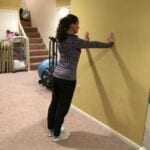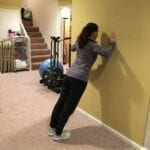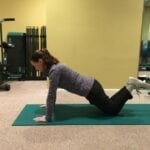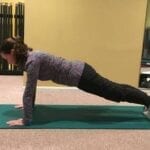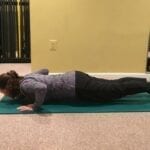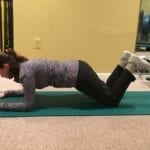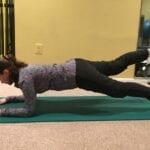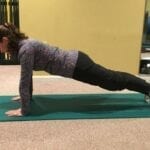Written by Marsha Seidelman, M.D.
Co-Author Jody Miller, M.A., RCEP
March 13, 2019
Today we’ll be talking about exercises that focus on prevention of osteopenia and osteoporosis. Aside from being beneficial for bones, these routines can help improve endurance, strength, posture and balance and in so doing, decrease the risk of falls and fractures.
Dr. Aruna Nathan’s recent article described lifestyle measures to maintain healthy bones, such as a good diet rich in protein and calcium, vitamin D supplementation, regular exercise and refreshing sleep.
In the video above and photos below, Jody Miller demonstrates exercises that strengthen the back muscles and core and improve posture using your own body weight. Upcoming articles will continue to focus on strength and balance, good posture, flexibility and awareness of your surroundings and will feature other exercises uses bands or a step. If you’re in prevention mode, all of these exercises are reasonable, guided by the limits of any other health matters you may have. If you have already been diagnosed with osteopenia or osteoporosis, we recommend that you check with your physician before attempting new challenges.
For the sake of pointing out various ways that exercise helps bone health, we have categorized activity below according to specific goals. However, there are overlapping benefits to any exercise. For instance, dancing is weight bearing and can help posture and balance.
Surprisingly, there is no evidence that running or jumping is of any greater benefit than walking, when it comes to bone density. In fact, once osteoporosis is present, jumping may cause a vertebral fracture. Even with the highest impact exercises, there may be little or no change in the numbers on your bone density scan, but the risk of fractures is significantly decreased, especially in the hip. This may be due to protection from increased muscle bulk and strength and decreased incidence of falls related to improved balance. It is also possible that the way we measure bone density may not accurately reflect the changes that occur with exercise. In any case, many of these exercises are good for your heart, good for your brain, and good for avoiding fractures.
FOCUS OF EXERCISE:
- Weight bearing
- High impact – running, jogging, dancing, tennis, stepping/jumping
- Low impact – walking, hiking, ‘lighter’ dancing
- Non-impact – elliptical, cycling, body weight training
- Resistance
- Swimming, yoga, pilates
- Strength training with weights, bands and tubing
- Posture and Balance
- Mechanics for sitting, standing and walking
- Non-weight bearing strengthening
WEIGHT-BEARING and RESISTANCE EXERCISES:
- Walking most days, with a goal of 30 minutes is helpful. Each step should exaggerate a heel to toe push-off to maximize flexing of the buttock muscles. This motion increases the impact on strength and bone density.
- Adding stairs to your routine, or varying the incline and pace on a treadmill would yield increased benefit.
- Uneven surfaces, like grass or dirt paths, also challenge balance and different muscles, but of course they also add to the risk of falling if you’re unsteady.
- Walking poles improve stability and add upper body resistance to walking, and are beneficial as long as they are the proper height. You should be able to stand upright and look ahead, rather than bend down to them.
- Walking side to side and forward and backward use different muscles and add a balance challenge – do this adjacent to a kitchen counter or other surface for safety.
- There is no scientific basis for vibrating platforms to stimulate bone growth.
- Many exercises can be done using your own body weight, such as wall pushups, regular pushups, bridges or planks – see the video above.
- Wall sits, chair squats and lunges all are other variations of body weight exercises, using the lower body.
- Belts or straps are helpful to increase joint range of motion and flexibility, especially for the shoulders and back. Without a strap, you can lie on the floor and do ‘angels in the snow’.
- Free weights need to be used with proper technique, so be sure to consult a trainer to avoid injury.
POSTURE:
- Stand or sit tall as much as you can. The hours many of us spend in front of one screen or another results in curvature of the upper back. Instead, you should aim for the top of your head to reach for the ceiling, and your shoulders to remain down and relaxed.
- When seated, try to sit a little bit forward on the chair to keep your back comfortable but straight, without slouching. There should be a natural curve inward at the lower back.
- Heavy handbags or shopping bags should be avoided, as they tend to curve your spine to the side. Wearing a backpack or pushing a load evenly with both arms is preferable.
BALANCE:
- When you stumble, having good balance can be the difference between keeping yourself upright or falling on the ground and sustaining an injury.
- Be aware of your surroundings. The smallest unexpected crack in the ground or branch on the trail can cause a fall.
- Everyone’s balance worsens with age. You can improve your balance with practicing these simple routines.
- When standing, balance on one leg, building up to, say 20 seconds at a time, always with the back of a chair or other object in close range.
- When that becomes easy, you can try turning your head while standing on one foot. It’s not easy! But you can practice any time you’re watching TV, talking on the phone, or have a free moment!
- Step up – step down on the bottom step of a flight of stairs. Each time you step, you are balancing on one foot at a time until the other foot lands.
ODDS and ENDS for BACK SAFETY and AVOIDING FALLS:
- For lifting an object off of the floor, try to hinge at the hips, keep your back straight, and your head above your heart, as you would in a squat. Try to avoid bending with your head down. In addition to possibly straining your back, you may become dizzy as you stand up, especially if you take high blood pressure medicine.
- Similarly, if you are seated and need to tie your left shoe, you should cross your left foot over your right knee. If instead you lean over to the floor to tie that shoe, you are more likely to lose your balance and fall forward. Also, once osteoporosis exists, that bend and twist motion can cause damage at the front border of the spine.
- Similarly for raking or shoveling, avoid twisting your spine under pressure. Sports like tennis, bowling and golf also incorporate these movements, so if you participate in these and have osteoporosis, you should check with your doctor.
- Above all, the exercises you choose to do should be enjoyable, or you’ll opt out after a short while. Walking outdoors with a friend and incorporating inclines in your route, preferably near a body of water or other beautiful scenery, fits the bill perfectly. Let us know if you have good tips for our other readers! Stay tuned for more exercise info!
References:
Walk Tall – An exercise program for the prevention and treatment of back pain, osteoporosis and the postural changes of aging, by Sara Meeks, PT, MS, GCS
LadyDocsCornerCafe articles:
Jody Miller’s abdominal exercises
Marsha Seidelman’s Protein sources
Aruna Nathan’s recent article about osteopenia and osteoporosis
Calcium info:
Sample Workouts for Older Adults from NIH:
Examples of endurance, strength, balance and flexibility exercises
Tags: balance, osteopenia, osteoporosis, resistance, strength

